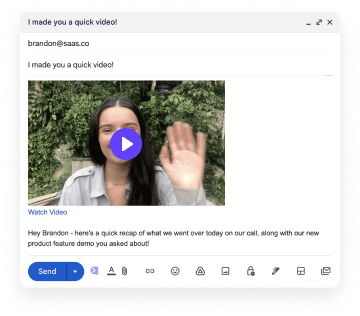Blame it on technology or blame it on choice overload, but consumer-seller communication is as complex and volatile as one can only imagine. Just as a wake-up call, 44% of Millennials prefer absolutely no interaction with salespeople when making a purchase.
By no means does that imply sales teams should hang up their gloves, but the way they reach out to buyers has to change drastically. Sales outreach cannot be universal to all prospects and customers, and even the good-old personalization & segmentation tactics won’t cut it any longer.
Marketing and sales professionals are always on the lookout for more efficient ways to engage with customers to beef up their ROI, and intent-based outreach just happens to be that latest strategy.
Now then, what's all this fuss about?
The power of intent-based outreach
Sales reps stay alert for what we call intent data, in other words - signals that give insight into prospects’ intentions and how purchase-ready they are.
Businesses implementing an intent-based strategy will undoubtedly see an increase in ROI. Here are just a few reasons why that’s so:
- For starters, intent data is like gold to sales and marketing teams as it provides insight into where each prospect is in the customer journey, what they’re looking for, what options they’re considering, and why.
- As a result, intent-based outreach takes targeting to a whole new level. Grouping your prospects by their buying signals allow sales reps to tailor separate, hyper-relevant outreach paths for each intent level, at each stage in the customer journey.
- Which means more optimal and targeted content, messaging, follow-ups, outreach channels, and a personalized customer experience like never before. Besides, outreach sounds way more fun when you know it will work, right?
- Businesses can prioritize channeling most of their resources towards “hot” leads that have shown signs of being purchase-ready. The result - more closed deals, resulting in more revenue, simple as that. (This approach allowed us to qualify our leads at a significantly faster rate, and there’s no going back now!)
- Intent data isn’t just for prospects but for existing customers as well. Stay one step ahead of any upsell, cross-sell, or retainment opportunities.
- You get the power to adjust and customize the customer journey by seeing the world through their eyes - what gets their attention and what is a potential deal-breaker.
Sounds great, so how do we do it?
Salespeople and marketers set up the processes and tools to effectively pick up buying signals from prospects. For each buying signal - there is a unique outreach sequence patiently waiting to do its magic.
You can scavenge intent-data first-hand (through website/social media analytics) or with the help of third-party vendors (social listening tools, intent data providers, B2B marketing databases). These analytics will give sales reps all the information necessary to understand their prospects’ intentions, and plan your outreach accordingly.
Intent data is only useful if one knows what to do with it, so here are some of our top intent-based outreach tactics that have been proven effective.
5 intent-based outreach tactics to implement
1. Hiring intent
Sales outreach based on hiring intent is one of the most powerful tactics for software/B2B companies like us. Easy to implement, easy to scale, and highly effective.
Using the top job boards, you can locate end-user companies that fit your ICP and are actively looking for new team members. Sales reps get a clear picture of how much the targeted company is expanding, in which direction, what technology they would potentially need to add/change, and much more.
In our case, we use LinkedIn and Glassdoor to search for SDRs, BDRs, AEs, Sales Executives, etc. to find companies looking to grow their sales team. After some research, we then find company representatives who best match our ICP, and simply add them to our existing ‘hiring intent’ outreach sequence.
Our sequence’s 1st email template mentions us noticing that the company is expanding to show that we’ve done our homework. We also use this opportunity to add a personalized video or picture to break the ice.
Our most recent hiring-intent outreach produced an 80% open rate and a 22% reply rate, which we were quite happy with.
2. Research intent
Buyers nowadays have all the means to research and compare products before making a purchasing decision. While that means less direct sales engagement, it’s a wonderful opportunity to see the world through the eyes of your prospects.
With the proper tools at hand, we can find out what our ideal targets are searching for, which products they are considering, and most importantly why. These answers make it easy to split leads into hot, warm, and cold based on how purchase ready they are.
For example, we’ve found that software review websites like G2 could be a great place to start. The platform can tell us how many and which companies visited our product page and our product category in general so we can pinpoint prospective customers as soon as they start considering our solution. Although, I must say, that this information comes at a price.
This could help our sales team prioritize their time and resources on the hot leads as they are the ones on the verge of making a purchasing decision.
If our product was already under their search umbrella - great, time to double down on personalized outreach and focus on their business’s unique pain points identified through research.
If the purchase-ready leads are considering our competitors while unaware of us - we focus on driving them to our website/targeted landing page with retargeting campaigns to add our product to their list of options.
3. Engagement intent
The best way to learn prospects’ intent is to just talk to them, right? Unfortunately, in modern-day sales, that’s not that easy anymore, but there are ways to identify, track, and analyze virtually all their engagement with our businesses.
With web analytics, we can pick up crucial buying signals that show us the intent of the engagement.
In this case, prospects that visit our pricing page 3+ times are most probably considering a purchase, and our sales reps have a proven template on standby that looks something like this:
Did they instead spend ages on our blog 5+ times without once clicking on the pricing or company page? Most probably they’re here for the content, and that’s totally cool! We add them to our cold lead sequence, keep them informed about new articles & ebooks, and who knows, maybe one day convert them to paid customers.
The exact same logic applies to social media (likes, follows, comments), cold email outreach (click-throughs), event marketing (webinar sign-ups), and other forms of engagement depending on your unique market.
4. Technographic intent
This form of intent only applies to SaaS sales, but it provides priceless information. We can identify what technology our targets are using at the moment, whether our technology could be complementary, when they will need to look for a new solution, etc.
We sometimes combine this with hiring intent by identifying expanding companies that potentially need a new sales solution to accommodate a growing team. Similarly, we connect with companies who are existing users of complementary-to-us products, which in our case would be sales intelligence tools, for example.
To make this happen, we outsource to third-party tools like Builtwith or Zoominfo that provide us with the validated technographic data. Within just a few clicks we can get a full list of companies and websites using Hubspot - one of the most popular CRMs we natively integrate with.
We can then sort this list by country, industry, and sales revenue to find those who would be most interested in our product. ZoomInfo even provides valuable, otherwise-unknown data on those companies which will make sales outreach that much easier.
A powerful straightforward email like the one suggested by ZoomInfo as the last step in our technographic intent-based outreach:
5. Active purchase intent
Just like a full-course meal, we saved the best for last (dessert, obviously). There are times when powerful buying signals are just staring in our faces.
For instance, the moment our sales reps get a notification about a lead signing up for a free trial - just like that they should be placed at the top of our priority outreach list. This is a lead one step away from becoming a paid customer.
Our sales team makes the outreach focused on how their specific business could benefit and maximize their sales with our product - explaining how it works and how they could scale their sales engagement.
Same goes for prospects asking questions in our live chat or requesting a demo - they are burning-hot leads that deserve more urgent and personalized outreach, it would be wrong to contact them the same way as cold prospects.
Intent-based outreach as an integral part of ABM
Account-Based Marketing (ABM) is a modern-day bridge connecting sales and marketing departments that team up to create hyper-targeted and hyper-personalized campaigns for each distinct group of customers. A whopping 94% of B2B businesses work with ABM, meaning probably so does your firm, whether you know it or not.
Where’s the connection, you may ask. Well, intent data is the centerpiece of modern ABM. You see, before, companies’ accounts were grouped, and hence targeted, by something way too general, location or industry, for example.
The rise of intent-based data and outreach has magnified the average marketing ROI while also improving brand reputation as a result of personal, relevant, and meaningful engagement.
Over to you
Some people want sales assistance throughout the entire customer journey, while others prefer doing everything themselves. Some people are just browsing through and daydreaming, while others are on the verge of making massive purchases.
With intent-based data, salespeople and marketers can create separate outreach campaigns for every person in every given scenario. All this while prioritizing their time and resources on high purchase intent accounts, making the most of their budgets, and closing more deals. What’s there not to like?
Intent-based sales and marketing are the present and future of business - there’s still time to get on board and ahead of your competition, but the window will start closing shortly.




